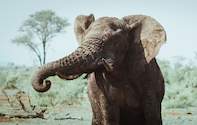
What Fruit do Elephants Eat to Get Drunk?
Elephants become drunk when they forage on the fruit of the marula tree - this is an ongoing myth and tale that has been established now for many years. Elephants are attracted to alcohol but it's not possible to become drunk by eating marulas in the veld says a scientific study conducted by Steve Morris from the University of Bristol. He believes the tales of drunkenness may be the result of humanising elephant behaviour.
Morris used some of the following statistics to calculate the likelihood of elephants becoming drunk on marulas. The average human body weight is 70 kg, while elephants weigh between 5000 and 6000 kg for males and 2500kg to 3000 kg for females. For a human to get intoxicated he needs to consume 90ml of 100 percent ethanol.
If this is extrapolated to elephants then elephants must consume 3800ml of 100 percent ethanol to get intoxicated. Ethanol is never pure in nature, and in marulas the alcohol content is never more than seven percent, meaning that an elephant must consume 55 litres of marula juice to obtain the equivalent amount of alcohol.
However, if the different metabolic rates of elephants and humans are taken into account, less alcohol is necessary to intoxicate an elephant. Taking into consideration the blood volume of an elephant and their metabolic rate, 1.9 litres of pure ethanol are needed to make an elephant drunk.
This translates to 27 litres of marula juice. Having looked at how much marula juice is needed, the number of marulas needed to produce drunkenness can be calculated. Marula trees produce approximately 8000 fruits and the weight of a marula is about 42g. Based on the fact that the average marula contains 22ml of juice, and using the unlikely assumption that each marula would have fermented to contain exactly seven percent alcohol, an elephant would have to eat about 1500 fermented marulas to get drunk.
Can Elephants Get Drunk On Marulas ?

Elephants can consume one to two percent of their body mass per day. Thus an elephant eating only marulas may eat in the region of 30 kg of marulas in one day or approximately 714 individual fruits. This is less than half the amount of marulas needed to produce intoxication, and is based on several assumptions that are unlikely to occur in the field. There have been reports of elephant behaviour that resemble an intoxicated state, but the calculations show that this is unlikely to occur only from eating marulas.
There are speculations that the behaviour may come from eating beetle pupae that live in the bark of the marula tree. These pupae have traditionally been used by the San people to poison their arrow tips, and if an elephant eats the pupae it may cause some behavioural changes. Another explanation is that the strange behaviours are most often reported for bull elephants, and this may be because the marula is a prized food item and the behaviour is simply the defence of the food resource.
By Philip de Bruyn

